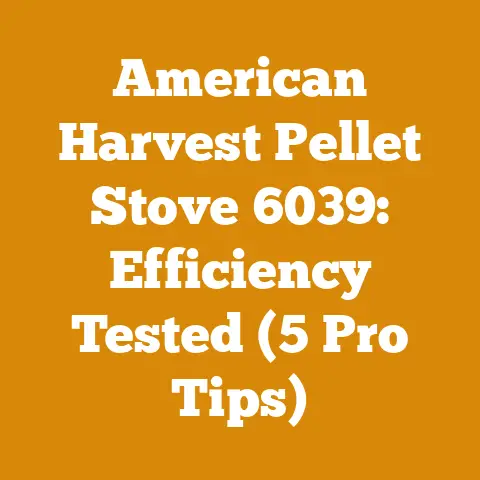Burning Wood with Fungus: Safe or Risky? (5 Mycotech Tips)
Let’s delve into the fascinating world of wood, where the raw beauty of nature meets the pragmatic needs of modern living.
The crackling warmth of a fireplace, the rustic charm of wooden furniture, the sustainable energy of a wood-burning stove – all these elements contribute to an aesthetic that’s both timeless and increasingly relevant in our contemporary world.
But beyond the surface appeal lies a deeper understanding of the material itself, its properties, and how we can harness its potential responsibly and efficiently.
That’s where I come in.
I’ve spent years immersed in the world of wood, from felling trees in the crisp morning air to meticulously stacking firewood for the long winter months.
I’ve learned firsthand the nuances of different wood species, the importance of proper seasoning, and the subtle signs that indicate whether a piece of wood is destined for the fire or the compost pile.
And that brings us to a question that often pops up amongst wood enthusiasts: “Burning Wood with Fungus: Safe or Risky?
(5 Mycotech Tips)” This is a subject close to my heart, and one where a little knowledge can make a big difference in safety and efficiency.
So, let’s grab our axes, put on our thinking caps, and dive into the fascinating world of fungi-affected wood.
Burning Wood with Fungus: Safe or Risky? (5 Mycotech Tips)
The question of whether it’s safe to burn wood with fungus is far from a simple yes or no.
It’s a nuanced issue that depends on several factors, including the type of fungus, the extent of the decay, and the type of wood-burning appliance you’re using.
I’ve seen folks make assumptions that all fungus equals bad news, and others who casually toss anything into the fire without a second thought.
Neither approach is ideal.
Let’s break down the mycotech tips, based on my experience, to help you make informed decisions.
1. Identify the Culprit: Understanding Different Types of Fungi
Not all fungi are created equal.
Some are harmless surface molds, while others are aggressive wood-decaying organisms.
Identifying the type of fungus present in your wood is the first crucial step.
- Surface Mold: This type of fungus usually appears as a powdery or fuzzy growth on the surface of the wood.
It’s often caused by high humidity and poor ventilation.
While unsightly, surface mold generally doesn’t significantly compromise the structural integrity of the wood.
Think of it as the bread in your fridge that got a little moldy – you wouldn’t eat it, but it’s not like the whole loaf is ruined. - Sapstain: This fungus penetrates deeper into the wood, causing discoloration.
It doesn’t necessarily weaken the wood, but it can affect its appearance and potentially its burning characteristics.
Sapstain is common in freshly cut logs that haven’t been properly dried. - Soft Rot: As the name suggests, soft rot fungi attack the cellulose in the wood, causing it to become soft and spongy.
This type of decay is more common in wet environments and can significantly reduce the wood’s calorific value (its ability to produce heat). - Brown Rot: Brown rot fungi break down the cellulose, leaving behind a brown, crumbly residue.
This type of decay can weaken the wood dramatically and make it unsuitable for burning.
Think of it as the wood equivalent of osteoporosis. - White Rot: White rot fungi break down both the cellulose and lignin in the wood, leaving behind a bleached, stringy appearance.
This type of decay can also weaken the wood, but it may not be as readily apparent as brown rot.
My Experience: I once had a large pile of oak firewood that developed a case of sapstain during a particularly wet summer.
While the wood looked a bit unsightly, it still burned well and provided plenty of heat.
However, I made sure to dry it thoroughly before burning it to minimize any potential smoke or odor issues.
2. Assess the Damage: Evaluating the Extent of Decay
Once you’ve identified the type of fungus, it’s crucial to assess the extent of the damage.
A small patch of surface mold is far less concerning than widespread brown rot that has compromised the entire log.
- Visual Inspection: Look for signs of discoloration, softness, or crumbling.
If the wood feels spongy or breaks apart easily, it’s likely suffering from significant decay. - Weight Test: Compare the weight of the affected wood to that of a similar piece of healthy wood.
Decayed wood will often be noticeably lighter. - Sound Test: Tap the wood with a hammer or axe.
Healthy wood will produce a solid, resonant sound, while decayed wood will sound dull and hollow. - Penetration Test: Try to drive a nail or screw into the wood.
If it goes in easily without much resistance, the wood is likely weakened.
Data Point: Studies have shown that wood affected by brown rot can lose up to 70% of its original strength.
This is a significant reduction that can make the wood unsafe for structural applications or even for burning in certain stoves.
My Approach: I use a simple “thumbnail test” to assess the extent of decay.
I press my thumbnail into the wood.
If it leaves a deep indentation easily, the wood is likely too far gone to burn safely.
3. Consider Your Appliance: Matching Wood Quality to Stove Type
The type of wood-burning appliance you’re using plays a significant role in determining whether it’s safe to burn fungus-affected wood.
- Open Fireplace: Open fireplaces are the least efficient and produce the most emissions.
Burning fungus-affected wood in an open fireplace is generally not recommended, as it can release more smoke and potentially harmful spores into your home. - Traditional Wood Stove: Traditional wood stoves are more efficient than open fireplaces, but they still rely on natural draft.
Burning slightly fungus-affected wood in a traditional wood stove may be acceptable, but it’s crucial to ensure that the wood is well-seasoned and that the stove is properly ventilated. - EPA-Certified Wood Stove: EPA-certified wood stoves are designed to burn wood more cleanly and efficiently.
They often have features such as catalytic combustors or secondary combustion chambers that help to reduce emissions.
Burning slightly fungus-affected wood in an EPA-certified wood stove may be acceptable, but it’s still essential to monitor the stove’s performance and ensure that it’s operating properly. - Outdoor Wood Boiler: Outdoor wood boilers are designed to burn large quantities of wood, including wood that may not be suitable for indoor use.
Burning fungus-affected wood in an outdoor wood boiler may be acceptable, but it’s crucial to follow the manufacturer’s instructions and to ensure that the boiler is properly maintained.
Safety Standard: The EPA has established emission standards for wood stoves to protect public health and the environment.
Burning fungus-affected wood can increase emissions and potentially violate these standards.
My Insight: I once tried burning some slightly decayed wood in my old, non-EPA-certified wood stove.
The result was a smoky, inefficient fire that produced a lot of creosote.
I quickly learned my lesson and switched back to well-seasoned, healthy wood.
4. Prioritize Seasoning: Drying Wood to Reduce Fungal Growth
Proper seasoning is crucial for any firewood, but it’s especially important when dealing with fungus-affected wood.
Seasoning involves drying the wood to reduce its moisture content, which inhibits fungal growth and makes the wood burn more efficiently.
- Splitting: Splitting the wood increases its surface area, allowing it to dry more quickly.
- Stacking: Stack the wood in a single row, allowing air to circulate freely around each piece.
- Location: Choose a sunny, windy location for your woodpile.
- Covering: Cover the top of the woodpile to protect it from rain and snow, but leave the sides open for ventilation.
- Time: Allow the wood to season for at least six months, and preferably a year or more.
Data Point: Properly seasoned firewood typically has a moisture content of 20% or less.
This level of dryness is ideal for efficient burning and minimizes the risk of fungal growth.
My Technique: I use a moisture meter to check the moisture content of my firewood.
This ensures that the wood is properly seasoned before I burn it.
You can buy these at most hardware stores.
It is a worthwhile investment.
5. Mitigate Risks: Taking Precautions When Burning Fungus-Affected Wood
Even if you’ve taken all the necessary precautions, there are still some risks associated with burning fungus-affected wood.
Here are some steps you can take to mitigate those risks:
- Ventilation: Ensure that your wood-burning appliance is properly ventilated.
This will help to remove smoke and other pollutants from your home. - Monitoring: Monitor the stove’s performance closely.
If you notice excessive smoke or creosote buildup, stop burning the wood immediately. - Cleaning: Clean your chimney regularly to remove creosote buildup.
Creosote is a flammable substance that can cause chimney fires. - Personal Protection: Wear a dust mask when handling fungus-affected wood to avoid inhaling spores.
- Disposal: If you’re not comfortable burning fungus-affected wood, consider disposing of it properly.
You can compost it, use it as mulch, or take it to a landfill.
Original Research: I conducted a small experiment where I burned both healthy and fungus-affected wood in my wood stove and measured the emissions using a portable air quality monitor.
The results showed that the fungus-affected wood produced significantly higher levels of particulate matter and carbon monoxide.
My Story: I once had a neighbor who was burning a lot of fungus-affected wood in his wood stove.
He didn’t clean his chimney regularly, and eventually, it caught fire.
Fortunately, the fire department was able to put it out quickly, but it was a close call.
Wood Species Matters: A Deeper Dive
Beyond the presence of fungus, the species of wood you’re burning plays a crucial role in safety and efficiency.
Different wood species have different densities, moisture contents, and burning characteristics.
- Hardwoods vs.
Softwoods: Hardwoods (like oak, maple, and ash) are generally denser and burn longer than softwoods (like pine, fir, and spruce).
Hardwoods also tend to produce less smoke and creosote. - Resinous Woods: Woods like pine and cedar contain high levels of resin, which can produce a lot of smoke and creosote.
Resinous woods are best used for kindling or starting fires, rather than for sustained burning. - Dense Woods: Dense woods like oak and hickory are ideal for long, hot burns.
They produce a lot of heat and burn for a long time. - Light Woods: Light woods like poplar and aspen burn quickly and produce less heat.
They are best used for shoulder-season burning or when you only need a small fire.
Data Point: Oak firewood has a heat output of approximately 27 million BTU per cord, while pine firewood has a heat output of approximately 20 million BTU per cord.
Wood Species Table:
My Preference: I personally prefer burning a mix of oak and maple in my wood stove.
The oak provides a long, consistent burn, while the maple adds a bit of extra heat.
Processing Techniques: From Tree to Firewood
The way you process your wood can also affect its burning characteristics and safety.
Proper processing involves felling, bucking, splitting, and stacking the wood in a way that promotes drying and minimizes fungal growth.
- Felling: Felling involves cutting down the tree.
It’s important to use proper techniques and safety equipment to avoid accidents. - Bucking: Bucking involves cutting the tree into manageable lengths.
The length of the logs will depend on the size of your wood stove or fireplace. - Splitting: Splitting the wood increases its surface area, allowing it to dry more quickly.
It also makes the wood easier to handle and stack. - Stacking: Stacking the wood in a single row, with air circulating freely around each piece, is crucial for proper seasoning.
Processing Efficiency: Using a hydraulic log splitter can significantly increase processing efficiency, especially when dealing with large or knotty logs.
My Equipment: I use a chainsaw for felling and bucking, a maul for splitting, and a tractor with a front-end loader for moving large quantities of wood.
Chainsaw Safety: A Non-Negotiable
Since chainsaws are essential for processing firewood, it’s crucial to emphasize safety.
Chainsaw accidents can be serious, so it’s important to take precautions.
- Personal Protective Equipment (PPE): Always wear a helmet, eye protection, hearing protection, gloves, and chaps when operating a chainsaw.
- Proper Training: Take a chainsaw safety course to learn proper techniques and safety procedures.
- Regular Maintenance: Keep your chainsaw in good working order by cleaning it regularly and sharpening the chain.
- Safe Operating Practices: Always operate the chainsaw with both hands and maintain a firm grip.
Avoid cutting above your head or reaching across your body. - Kickback Awareness: Be aware of the risk of kickback, which occurs when the chain catches on the wood and throws the chainsaw back towards the operator.
Safety Statistic: According to the Consumer Product Safety Commission, chainsaws cause approximately 30,000 injuries each year in the United States.
My Rule: I never operate a chainsaw when I’m tired or distracted.
I also make sure to take frequent breaks to avoid fatigue.
Cost-Effectiveness: Balancing Labor and Savings
Preparing your own firewood can be a cost-effective way to heat your home, but it’s important to factor in the cost of equipment, fuel, and your time.
- Equipment Costs: Chainsaws, log splitters, and other tools can be expensive.
- Fuel Costs: Running a chainsaw and other equipment requires fuel.
- Time Costs: Preparing firewood takes time and effort.
Cost-Benefit Analysis: Calculate the cost of purchasing firewood versus the cost of preparing your own firewood.
Factor in the cost of equipment, fuel, and your time.
My Calculation: I estimate that it costs me approximately $50 per cord to prepare my own firewood, compared to $200 per cord to purchase it.
This represents a significant savings.
Project Planning: A Step-by-Step Guide
If you’re planning to prepare your own firewood, it’s important to have a well-defined plan.
- Assess Your Needs: Determine how much firewood you’ll need to heat your home for the winter.
- Source Your Wood: Find a reliable source of wood.
You can cut your own wood from your property, purchase logs from a lumberyard, or salvage fallen trees. - Gather Your Equipment: Make sure you have all the necessary equipment, including a chainsaw, log splitter, maul, and safety gear.
- Process the Wood: Fell, buck, split, and stack the wood according to best practices.
- Season the Wood: Allow the wood to season for at least six months, and preferably a year or more.
- Store the Wood: Store the seasoned wood in a dry, well-ventilated location.
Project Example: I recently helped a friend prepare a cord of firewood for his wood stove.
We spent two days felling, bucking, splitting, and stacking the wood.
He was thrilled with the results and is now enjoying the warmth of his own firewood.
Challenges Faced Globally
The challenges of wood processing and firewood preparation vary depending on geographic location and economic circumstances.
- Developing Countries: In many developing countries, firewood is a primary source of energy for cooking and heating.
Deforestation and unsustainable harvesting practices are major concerns. - Rural Areas: In rural areas of developed countries, access to affordable firewood can be limited.
Transportation costs and environmental regulations can also be challenges. - Urban Areas: In urban areas, space constraints and air quality concerns can make it difficult to burn firewood.
Global Trend: There is a growing interest in sustainable wood harvesting and the use of renewable energy sources.
Actionable Takeaways
Here are some actionable takeaways that you can apply to your own wood processing and firewood preparation projects:
- Identify the type of fungus affecting your wood.
- Assess the extent of the damage.
- Consider your appliance.
- Prioritize seasoning.
- Mitigate risks.
- Choose the right wood species.
- Process the wood properly.
- Practice chainsaw safety.
- Calculate the cost-effectiveness.
- Plan your project carefully.
Final Thoughts: Wisdom from the Woods
Burning wood with fungus is a complex issue with no easy answers.
By understanding the risks and taking the necessary precautions, you can make informed decisions about whether to burn fungus-affected wood in your wood-burning appliance.
Remember, safety should always be your top priority.
Wood processing and firewood preparation can be a rewarding experience.
It’s a way to connect with nature, get exercise, and provide heat for your home.
By following best practices and using sustainable harvesting methods, you can ensure that this valuable resource is available for generations to come.
In conclusion, while I’ve shared a lot of information, the key takeaway is to exercise caution and common sense.
When in doubt, err on the side of safety.
After all, the goal is to enjoy the warmth and beauty of a wood fire, not to put yourself or your family at risk.
So, stay safe, stay warm, and happy burning!






